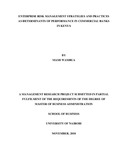| dc.description.abstract | As far as enterprise risk management strategies and practices are concerned, there appears to
be little done especially in Kenya. This creates a gap in literature that the present study
sought to bridge. This study differs from the previous ones because it focuses on a
developing nation, Kenya, which was not the focus of the previous studies hence such studies
cannot be generalized to Kenya. Further, the enterprise risk management is used in this study
as a strategic concept. This significantly shifts focus from the previous studies. The study
therefore sought to analyze the various risk management practices adopted by Commercial
Banks and their influence on bank performance in Kenya. A cross-sectional survey design
was used in this study. A total of 36 banks took part in the study (80% response rate). Both
primary and secondary data were collected. The primary data was collected through
questionnaires while secondary data was collected from annual statements. The
questionnaires were administered to the risk management staff using drop and pick later
method. Both descriptive statistics and inferential statistics (especially regression analysis)
were used in the analysis of data.
The regression analysis revealed that there was a very high significant positive correlation
between credit risk management practices and performance (R = 0.779, Sig. = 0.002). The R2
of 0.607 indicates that credit risk management practices influenced 60.7% of the variances in
performance of commercial banks. The results also indicate that liquidity risk management
practices had an insignificant positive influence on performance (R = 0.205, Sig = 0.545).
The R2 of 0.042 indicates that liquidity risk management practices influenced 4.2% of the
variances in performance of commercial banks. The results also show that interest rate risk
management practices had a significant positive influence on performance (R = 0.610, Sig =
0.046). The R2 of 0.372 indicates that interest rate risk management practices influenced
37.2% of the variances in performance of commercial banks. The study also revealed that
foreign exchange risk management practices had a significant positive influence on
performance (R = 0.902, Sig = 0.000). The R2 of 0.813 indicates that foreign exchange risk
management practices influenced 81.3% of the variances in performance of commercial
banks. | en_US |



